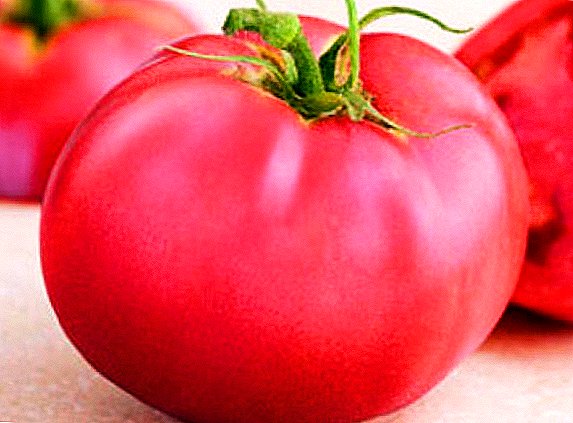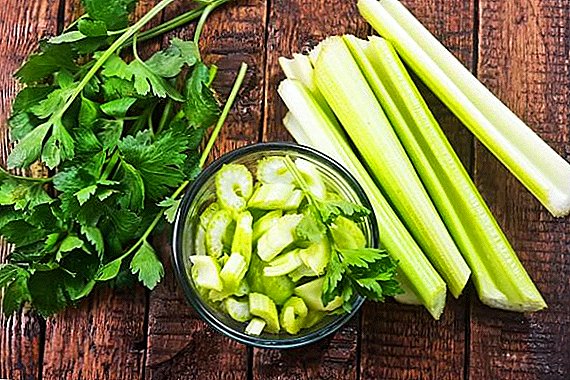 Celery is one of the most common garden crops. It is also a treasure trove of vitamins and trace elements.
Celery is one of the most common garden crops. It is also a treasure trove of vitamins and trace elements.
A variety of data about the plant, its benefits and use are systematized in our article.
Botanical description
Celery is a one or two year old plant belonging to the umbrella family. The culture has a huge tuber, massive juicy stalks and tops, similar to parsley, but slightly larger than it.  All parts can be eaten, but fresh stems are most used. The plant’s homeland is the Mediterranean, where it is still found in its uncultured form.
All parts can be eaten, but fresh stems are most used. The plant’s homeland is the Mediterranean, where it is still found in its uncultured form.
The composition of celery is as follows (per 100 grams):
- water - 82 g;
- carbohydrates - 7.1 g;
- proteins - 1.3 g;
- ash - 1.1 g;
- cellulose - 1 g;
- fats - 0.3 g;
- organic acids - 0.1 g
Vitamins are found in different parts of the plant. Most of all vitamin C is 8 mg, A, B1, B2, B3, B9 are much smaller. The caloric value of 100 grams of any part of celery is about 25-32 kcal. Low energy value makes this plant a dietary product.

The chemical composition includes the most potassium - 320 mg, there is also phosphorus, calcium, sodium magnesium - from 30 to 60 mg. Trace elements are iron, zinc and manganese.

Useful properties of the plant
All parts of the plant are useful for human health and are used in the prevention and treatment of many diseases. They can help from kidney ailments, the gastrointestinal tract, the reproductive system and many other diseases of the internal organs. In addition, cosmetology uses decoctions for hair and skin from this vegetable. 
Root use
Massive root has the highest medicinal value in the plant.
Its beneficial properties help to effectively treat many diseases:
- blood diseases and general weakness of the body (manifestations are reduced or eliminated by iron salts);
- diseases of the nervous system (are treated with salts of magnesium);
- relieves joint pain and increases mobility;
- improves metabolism, promotes weight loss and the removal of toxins from the body;
- helps with diseases of the cardiovascular system;
- improves the dynamics of treatment for kidney disease;
- increases overall health, body tone and lowers blood pressure;
- relieves stress and irritation;
- has a preventive effect on the onset of oncology;
- accelerates recovery from colds.
Learn more about what is useful and how to properly use celery root.
Stalk benefits
The diuretic effect of celery stalks keeps the urinary tract in good shape, relieving the body of excess fluid in time. In diabetic patients, vegetable stalks significantly reduce blood sugar levels. Also, this part of the culture helps fight blood pressure in hypertension and the growth of cancer cells.

In the event of overwork, stress and weakening of memory, fleshy stalks of the plant should be included in the diet. This will help to focus attention and provide a restful sound sleep.
Read more about the beneficial properties and the possible harm of stalked celery to the human body.
Seed benefits
Seeds are rich in volatile essential oils and vitamins, which can be useful for some ailments. Sunflower seeds are usually taken in the form of an extract in ampoules, capsules or tea from crushed raw materials. It is worth noting that the essential oils obtained from this part of celery are no worse than sea buckthorn oil.

Celery seeds are used in such cases:
- muscle aches, cramps and cramps - the substances contained in these seeds can reduce pain or even remove it, in some cases the effectiveness of the remedy is enough even for joint pains;
- for detoxification and cleansing - volatile compounds perfectly remove some toxic substances that lead to excessive fatigue, for example, uric acid;
- in reasonable quantity (a teaspoon with a hill) seeds can be taken as a harmless sleeping pill or sedative.
Important! Celery seed infusion is used as an aid to removing kidney stones.
Leaf benefits
Greens are not only healing qualities, which in varying degrees, repeat the properties of other parts of the plant. It is perfect for eating and normalizes the work of the food system, if a person has no contraindications. Celery is weak, so it can be used as a cure for constipation.

Fresh from fresh greens perfectly tones, improves mood and adds strength. A decoction of foliage helps to quickly reduce blood sugar levels. And adding tops in salads can diversify the taste and make them nutritious without increasing the number of calories.
We advise you to learn more about the beneficial and harmful properties of celery leaf.
Disease prevention and healing properties for the body
Above mentioned about the use of all parts of celery from various ailments. One of the most important applications is the prevention and treatment of problems in the genital area of both men and women.
Celery for male potency
Male potency is quite fragile and very dependent on the lifestyle and mental state. Drugs of medical origin may be able to eradicate the problem one-time or for a period of time, but you should not ignore the natural sources of male power.

With manifestations of prostatitis, there are problems with potency, which seriously violates not only the sex life of a man, but also his psychological state. You can try to strengthen the male power with prostatitis by drinking a quarter-glass of fresh fruit from the juicy part of the plant, its stems, twice a day.
Important! Men are encouraged to include this culture in any form in their daily diet.
Celery for women
For women, the plant helps to be beautiful: the most useful components that make up the culture take care of the skin. Also, essential oils help to gain mental calm, relax and tune in a positive way.

Useful properties for the woman's body can be fixed by including all parts of the culture in the diet. Stem juice, foliage salads, slices of boiled tubers and just sprigs to the table not only diversify the menu, but also have a beneficial effect on your well-being.
Use in traditional medicine
Traditional medicine knows many ways to use herbs and celery tubers for various ailments. It is more difficult to say where the plant is not used than to list all the groups of diseases from which it has long been used.
Good performance is observed in the treatment of diseases of the stomach - with gastritis, increased acidity and ulcers. Also, celery root in the composition of vitamin salads helps to fight the processes that destroy the thyroid gland. However, the best effect of the use of parts of this representative Umbrella in traditional medicine is noted in the treatment of problems with joints and diabetes.
 The main benefit of celery for human health is to maintain the body's defenses. Especially in seasons when avitaminosis lurks us at every turn - in winter and early spring.
The main benefit of celery for human health is to maintain the body's defenses. Especially in seasons when avitaminosis lurks us at every turn - in winter and early spring.
Celery for joints
For the treatment of joints, both the root of the plant and its above-ground part are suitable. Over the centuries, traditional medicine has chosen those recipes that can withstand joint diseases and effectively treat them.
Celery juice with lemon and honey
The preparation of this medicine is made according to one of two recipes.
Ingredients:
- cuttings - 1 kg;
- lemon (medium) - 5 pcs;
- honey - 1 cup.

Cooking method:
- Cut the lemons into halves or quarters and remove the bones.
- Wash the cuttings and chop them into large pieces.
- Put the lemons and stalks in a blender, chop them.
- In the mixture, enter the honey and mix thoroughly.
- Set aside the mixture in the refrigerator for three days.
- Store the container in a dark, dry place.
- Take the product on a tablespoon half an hour before meals for a month.
The sequence of preparation for the second recipe is the same, with the exception of the honey addition phase - it is poured into the mashed potatoes that have already settled in the refrigerator.
Read more about what is intended medical mixture of lemon, honey and celery.
Celery Root Infusion
Celery root has truly miraculous properties for the treatment of joints. We give a simple recipe for insisting raw materials.
Ingredients:
- root - 30 g;
- water - 1 cup.
Cooking method:
- Cut the roots of the plant into small pieces.
- Fill them with boiling water, cover and leave for two hours.
- Strain and take in a teaspoon before meals.

Celery root infusion with lemon and garlic
A good result gives the use of a mixture of root with lemon and garlic. This tool has a beneficial effect on the entire musculoskeletal system.
Ingredients:
- root - 250 g;
- lemon (medium or small) - 3 pcs .;
- garlic - 1-2 heads;
- water - 1-1.5 liters.

Cooking method:
- Cut the root into slices.
- Lemon cut into pieces and remove the bones.
- Separate the garlic and peel them.
- All pass through a meat grinder and put in a three-liter bottle.
- Fill with boiling water, cover, wrap and leave overnight.
- Take half an hour before meals for a third cup (about 70 ml).
The course is designed for three months, and at the end of the infusion it is necessary to prepare it again.
Celery with diabetes
Useful properties of the plant can help with diabetes. Given the low calorie content and low sugar content, there are several good recipes from this culture.
Did you know? According to researchers of British myths and legends, the love elixir for Tristan and Isolde (the poetic heroes of Scotland of the VIII century) consisted of celery juice, apple and pear in a ratio of 2: 1: 1.
Celery Broth
A decoction of this representative umbrella can reduce blood sugar levels.
Ingredients:
- fresh greens or part of the root - 20-30 g;
- water - 1 cup.
How to cook:
- Plant material cut into small pieces.
- Pour a glass of water and boil in a scoop for 20-25 minutes over low heat.
- Cool, strain and drink 2-3 tablespoons 3-4 times a day.
The course of application is a month, and after a week break you can begin a new course.

Celery Root Jam
For the treatment of diabetes with the culture in question, there is a rather exotic recipe: from the root of the plant, it is possible to make jam for those who cannot eat sugar.
Ingredients:
- root (medium-large or large) - 1 pc .;
- medium lemon - 3-4 pcs .;
- water (for bath) - 1 l.
The tool is prepared as follows:
- Wash the root, peel it and cut into slices that are convenient for the meat grinder.
- Cut the lemons into several pieces, depending on their size.
- Pass the fruit through a meat grinder.
- Put the resulting mass in a container and put it in a water bath.
- Evaporate the mixture for about two hours under a covered lid.
- Cool the jam and store it in the fridge.
 The resulting delicacy is used in the morning before breakfast on a tablespoon daily. You can use it as a jam for tea.
The resulting delicacy is used in the morning before breakfast on a tablespoon daily. You can use it as a jam for tea.
Use in cosmetology
Given the usefulness of the plant, its cosmetic properties are also at a high level. The main qualities are used in decoctions and infusions for the skin of the face, as well as to strengthen the hair. For the face, you can use the following decoction, which helps the skin to cleanse and stay in good shape.
Ingredients:
- root - 50 g;
- water - 400 ml.
Cooking:
- Cut the root into thin strips.
- Fill with water and boil.
- Cook on low heat for 15 minutes.
- Strain and pour into a vial.
Did you know? The plant has its semi-official capital - the American city in Colorado Arvada is called the celery capital of the world.
This decoction can be removed cosmetics from the face and tone the skin, giving it a rest. Facial infusion is also very useful, and its effect on the skin lasts for several hours. There are a large number of recipes that are based on insisting any part of the culture together with other fruits or plants - carrots, cucumbers, herbs, including field ones.
Video: Mask of carrots and celery tightening and complexion
Diluted with water in the same proportion, the juice of fresh stems can be rubbed into the hair to give them shine and healing. This fluid is also good for the scalp. In splitting and weak hair, you can rub a mixture of juice, sour cream and egg yolk in equal proportions.
Possible harm and contraindications
All the positive qualities of the plant will not be able to manifest if a person has any contraindications to its use in any form.
Consider who should not take this product - first of all, people with such diseases and features:
- idiosyncrasy, allergic reaction;
- ulcerative diseases of the gastrointestinal tract;
- kidney stones, especially large ones;
- diseases of the blood and veins - thrombophlebitis, varicose veins;
- late pregnancy;
- when breastfeeding.
Learn more about the characteristics of celery use during pregnancy.
Here are the possible side effects of the described representative Umbrella - an upset stomach and diarrhea.
Celery is an excellent useful plant, and not every garden crop can be compared with its components and properties. It finds its application in medicine, including folk, as well as in cosmetology and, of course, cooking.












